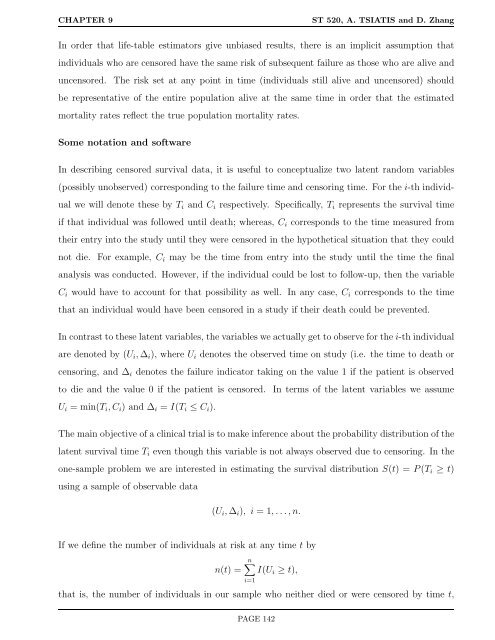ST 520 Statistical Principles of Clinical Trials - NCSU Statistics ...
ST 520 Statistical Principles of Clinical Trials - NCSU Statistics ...
ST 520 Statistical Principles of Clinical Trials - NCSU Statistics ...
You also want an ePaper? Increase the reach of your titles
YUMPU automatically turns print PDFs into web optimized ePapers that Google loves.
CHAPTER 9 <strong>ST</strong> <strong>520</strong>, A. TSIATIS and D. Zhang<br />
In order that life-table estimators give unbiased results, there is an implicit assumption that<br />
individuals who are censored have the same risk <strong>of</strong> subsequent failure as those who are alive and<br />
uncensored. The risk set at any point in time (individuals still alive and uncensored) should<br />
be representative <strong>of</strong> the entire population alive at the same time in order that the estimated<br />
mortality rates reflect the true population mortality rates.<br />
Some notation and s<strong>of</strong>tware<br />
In describing censored survival data, it is useful to conceptualize two latent random variables<br />
(possibly unobserved) corresponding to the failure time and censoring time. For the i-th individ-<br />
ual we will denote these by Ti and Ci respectively. Specifically, Ti represents the survival time<br />
if that individual was followed until death; whereas, Ci corresponds to the time measured from<br />
their entry into the study until they were censored in the hypothetical situation that they could<br />
not die. For example, Ci may be the time from entry into the study until the time the final<br />
analysis was conducted. However, if the individual could be lost to follow-up, then the variable<br />
Ci would have to account for that possibility as well. In any case, Ci corresponds to the time<br />
that an individual would have been censored in a study if their death could be prevented.<br />
In contrast to these latent variables, the variables we actually get to observe for the i-th individual<br />
are denoted by (Ui, ∆i), where Ui denotes the observed time on study (i.e. the time to death or<br />
censoring, and ∆i denotes the failure indicator taking on the value 1 if the patient is observed<br />
to die and the value 0 if the patient is censored. In terms <strong>of</strong> the latent variables we assume<br />
Ui = min(Ti, Ci) and ∆i = I(Ti ≤ Ci).<br />
The main objective <strong>of</strong> a clinical trial is to make inference about the probability distribution <strong>of</strong> the<br />
latent survival time Ti even though this variable is not always observed due to censoring. In the<br />
one-sample problem we are interested in estimating the survival distribution S(t) = P(Ti ≥ t)<br />
using a sample <strong>of</strong> observable data<br />
(Ui, ∆i), i = 1, . . ., n.<br />
If we define the number <strong>of</strong> individuals at risk at any time t by<br />
n�<br />
n(t) = I(Ui ≥ t),<br />
i=1<br />
that is, the number <strong>of</strong> individuals in our sample who neither died or were censored by time t,<br />
PAGE 142
















